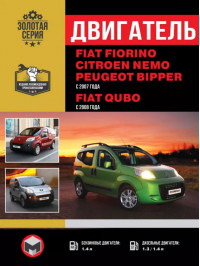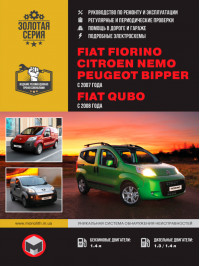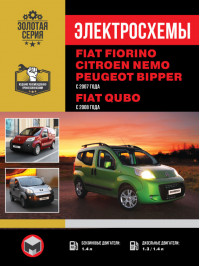Information on repair and maintenance of Fiat Fiorino cars electronically
The Fiat Fiorino is a small light commercial vehicle produced by the Italian company Fiat since 1977. Since this year, three generations of this light and compact van have been produced.
The first generation Fiorino was a commercial vehicle based on the Fiat 127. It was launched in November 1977 and was based on the second series Fiat 127. In 1982, it was restyled, becoming very similar in appearance to the Fiat 147 Sudamericano.
In March 1987, a version called "Fiorino Jolly" was launched on the market, available with two engines: a 1.1-liter petrol and a 1.3-liter diesel. Produced until 1988 at the Fiat Betim plants in Brazil and Fiat Córdoba in Argentina. The version of the pickup truck in Brazil was called Fiat 147 City.
The second generation was built on the platform of the Brazilian Fiat Uno, but there were three technically very different sub-series.
The front end of the version produced from the beginning of 1988 to the spring of 1992 was taken over from the Fiat Uno up to the B-pillar, as was the interior. On the other hand, the technology has hardly changed since the first Fiat Fiorino. It is based on the Brazilian Fiat Uno with a rear axle from the Fiat 127, recognizable by its higher hood with a spare tire underneath.
As before, entire components, such as the chassis and drive parts, were adopted directly from its predecessor. The suspension towers, suspension struts, front axle and rear axle, consisting of transverse double-leaf springs, trapezoidal wishbones and damper struts, were identical to those of the 147.
Originally called the Fiat 127 Fiorino, the first generation was based on the Fiat 127 with a rear end to which a cargo area was added. The platform is a stretched version of the Brazilian Fiat 147.
The second series of Fiat Fiorino was introduced in the spring of 1992 and was produced until the end of 1993. This series featured a body facelift stylized as the Fiat Uno II. However, the headlights, fenders, hood and grille were unique to the Fiorino in Europe and were not the same as the European Fiat Uno. These parts were borrowed from the Fiat Uno CS, which was produced only in Brazil. The interior remains the same, maintaining the appearance of the Fiat Uno I.
The Third Series, launched in early 1994 and in production until 2013, moved away from the Type 147's technology and the Fiat Uno I's appearance. The car's wheelbase and length were increased slightly, and the chassis and front axle geometry were developed based on the Fiat Uno. The rear axle became rigid and was suspended on two longitudinal leaf spring packages, which improved handling. The appearance has remained virtually unchanged compared to the second series.
These lower-end models can often be identified by their raised roof and slightly modified van body. The glazed or beaded sidewall portions had only two surfaces on each side instead of four. Later models of the third subseries received a different radiator grille with only one crosspiece. Fiat Uno II equipment was also found in the cabin of the third subseries.
Body styles included box van, glass van, and pickup truck. The latter is relatively rare and in demand. Motorhomes based on Fiat Fiorino were also offered.
In addition to the 1.7-liter diesel engine, the engine range included various gasoline engines with a displacement of 1.1 to 1.6 liters. Since the Fiat Fiorino was primarily a car for craftsmen, preference was given to the diesel engine, which in later models was still offered in a turbocharged version with 46 kW (63 hp).
In December 2000, sales of the Fiat Fiorino series were discontinued in Europe. Fiat Strada (based on Punto or Palio) and Fiat Doblo were presented as successors.
In Europe, the third generation Fiat Fiorino was introduced in 2007 and is produced by the TOFAŞ automobile group at the Turkish plant in Bursa. It is also sold under the Peugeot and Citroën brands under the names "Bipper" and "Nemo" respectively. It can withstand up to 610 kg of load. This model was also sold in South America, where it was initially sold under the name Fiat Fiorino Qubo, retained until 2015 when a new SUV based on the Fiat Uno Way was introduced, also called Fiorino. From that moment on, the small van produced by Sevel began to be called simply Fiat Qubo.
Owners of any vehicle, including Fiat Fiorino, are often faced with the need for maintenance and repairs. This directly affects the service life and safety of the vehicle. However, many problems can be solved on your own without contacting a car service.
Diagnosis, maintenance and replacement of parts require specific knowledge, understanding and skill. To do this, it is recommended to prepare in advance, including purchasing a special repair and operation manual.
On our website you can read a book on repairing Fiat Fiorino in electronic format absolutely free of charge. In addition, to always have the repair manual with you on the road, you can purchase and download it to your smartphone or tablet in PDF format.
This guide will answer many questions, including:
- how to detect faults in the fuel system and eliminate them;
- how to change the engine oil yourself;
- how to replace coolant in a car;
- electrical equipment;
- how to repair brake pads and much more.
The information in the book is presented in the simplest possible language and will be useful not only to professionals, but also to driving beginners. If necessary, you can also purchase separately electrical circuit diagrams for this model, which will be useful when repairing the vehicle's electrical equipment.





